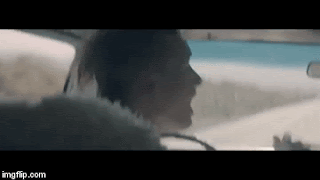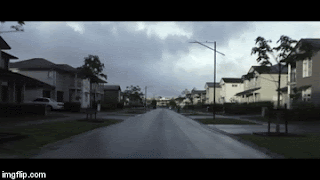Camera Shots/Movements/Angles:
Most of the camera shots in this video appear to have been filmed using a handheld camera. The shots have an unstable, wavering quality which makes the video appear more realistic, and increases elements of tension and chaos at certain points during the video. The realistic quality that using a handheld camera added to the video allows the audience to feel more involved in the narrative, as if they are watching the events unfold from the perspective of somebody who is actually in the video. Establishing shots haven't really been used in this music video, as it focuses mainly on the story involving the two main characters- setting is not a key element of this video. Close-up shots are used throughout this music video in order to emphasise the intensity of the narrative and to show the emotions of the characters through their facial expressions.
The editor has used simple jump cuts to change between clips/camera shots in this music video. This emphasises the realism of the video and doesn't distract attention from its plot. At the start of the video, the editing is fairly slow paced, reflecting the relaxed atmosphere of this part of the narrative. As the storyline dramatises, however, the editing becomes fast paced, the clips shorter and cuts more jumpy. This highlights the intense and chaotic mood that has developed within the video. The tones in this music video are quite subdued and muted, so a desaturation filter may have been added to the clips during the editing process to create this effect.
Mise-en-Scene:
The colours shown in this music video are quite dull and desaturated (mentioned above)- an effect that was most likely added during the editing process. This type of colour scheme seems to be popular within music videos of the indie pop genre, so in this way the band have conformed to a stereotype of their genre. The lighting in this music video appears to be purely natural, which again emphasises the realism of the narrative. There are some scenes in the video where the lighting creates artistic effects, for example when the two lead characters can be seen together as silhouettes. Professional lighting may have been used here in addition to natural lighting in order to create this effect. These types of artistic shots are common among music videos within the indie pop genre, and add interesting conceptual elements to narrative videos.
I think that the clothing worn by the characters in this music video could be viewed as typical of the genre. The female protagonist of the video can be seen mostly wearing outfits including plain high waisted jeans or shorts with patterned cropped tops. The clothing she wears in the music video is unusual and unique, and therefore fits the indie aspect of this genre. The male protagonist dresses predominantly in black, ripped skinny jeans with various shirts worn throughout the video. His clothing is edgy and fairly distinctive, which also fits the indie aspect of this genre.
Representation
In this music video, only the lead singer of the band features enough to show any real representation of character. The lead singer plays a seemingly dangerous character who appears to be quite romanticised. Throughout the video, he drinks, smokes, does drugs and plays with a gun whilst clearly intoxicated, all before robbing a supermarket and getting shot. These actions should in theory make him seem like an unappealing person, however, I think that the presence of a lover throughout the events of the video secure the artist with a desirable 'bad boy' type persona.
Genre of the music and how this is signified in the video
As mentioned previously, the genre of the music is indie pop. I think that the low saturation and muted quality of the colours in the video are indicative of the genre of music, as this is a common feature in alternative pop videos. The main characters in the video are young adults, and as Indie Pop is quite a modern and newly popular genre of music, the age of the characters in the video reflects this. The clothing of the characters in this music video is also relevant to the genre of music as it is quite unique and unusual- words that relate to the word 'indie'.
Intertextuality
There are no clear intertextual references within this music video. This is probably due to the genre being Indie Pop- the association of mainstream media is not a common feature for an Indie Pop music video to have. However, this music video could be interpreted as a homage to Bonnie and Clyde as it depicts a boy and a girl who are madly in love committing crime together.
Audience Reception
Stuart Hall's Audience Reception Theory demonstrates three ways in which an audience might read a media text. The theory of preferred reading is when the audience reads the text the way the author intended them to. The theory of negotiated reading is when the audience reads the text the way the author intended, but also uses their personal experiences and interests to modify their interpretation. The third theory is the oppositional reading theory, where the readers' social position means that they have an opposing relation to the text. Therefore, they reject the reading.
For The 1975's 'Robbers' music video, I think that the theory of preferred reading is the most relevant as there is a clear storyline for the audience to follow, therefore, they view the video the way that the artist intended. The theory of negotiated reading could also be applied to this video as a viewer could use their own positions and experiences to interpret certain elements of the storyline.
Uses & Gratifications- Why might an audience enjoy this video?
The Uses and Gratifications theory suggests that audience members are not passive, but take an active role in integrating media into their lives. It also states that audiences are responsible for choosing certain medias to meet their needs. It focuses on what people choose to do with media rather than the effect that the media has upon them. I think that an audience might watch this video to fulfil entertainment needs, as it has a compelling and gripping storyline.
Can Andrew Goodwin's theory be applied to the video? If so, where?
I think that elements of Andrew Goodwin's theory can be applied to this music video. For example, the video expresses genre characteristics such as a muted and dull colour scheme, and the involvement of both concept and narrative aspects. There is also some possible involvement of intertextuality in the video (Bonnie and Clyde reference mentioned above). The song is titled 'Robbers', and the narrative appears to show a couple robbing a supermarket together. The lyrics of this song make several references to guns, and a gun is featured in several clips in the video, so in this way, there is a link between lyrics and visuals, and Goodwin's theory can be applied.
Can Laura Mulvey's theory be applied to the video? If so, where?
Laura Mulvey coined the term 'Male Gaze', and believes that film audiences must view characters from the perspective of a heterosexual male. Her 'gaze' theory is made up of 3 aspects- how men look at women, how women look at themselves and how women look at other women.
The 'Male Gaze' theory states that the camera lingers on the curves of the female body, and the events that happen to her afterwards are largely based upon the male's reaction to this. It also demotes women to the status of objects, and gives the female viewer a secondhand experience of the narrative through identification with the male on screen.
I think that this theory can definitely be applied to The 1975's 'Robbers' music video. There are several shots where the camera seems to linger on the curves of the body of the female protagonist, and her main purpose in the video appears to be looking after or fulfilling the sexual desires of the male protagonist. I don't think that this quite denotes her to the status of an object, yet it still gives the audience the impression that she is purely a backup character to the male protagonist.
Are there any Binary Oppositions in the video? If so, where?
Levi Strauss came up with the theory of binary opposites. A protagonist and antagonist, or a hero and villain are typical examples of binary opposites. I don't think that there are any specific binary oppositions shown in this music video, however, at one point in the video, the male protagonist appears to play the part of the villain as he jokingly points a gun at the female protagonist's face, as she is visibly distressed. This could be viewed as an example of binary opposites.


























